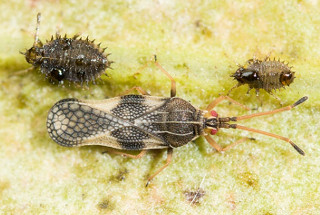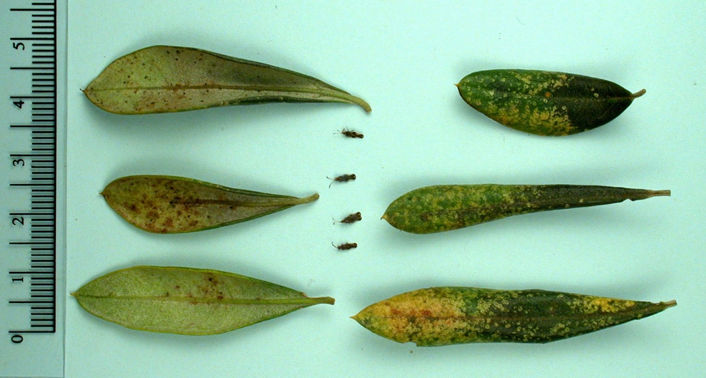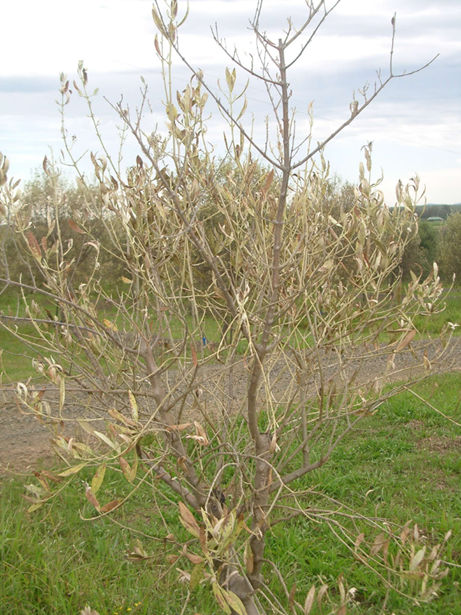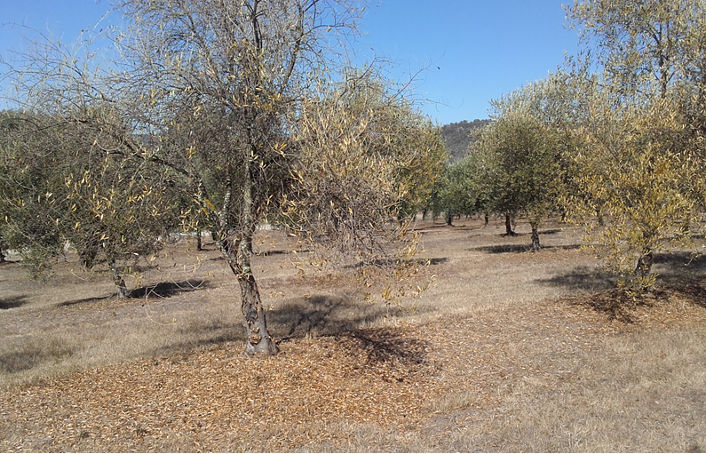Olive lace bug
The olive lace bug, Froggattia olivina is an Australian native sap-sucking insect that targets olive trees (Olea europaea).
It can reduce yields and kill trees if left untreated. Olive lace bug is considered a serious threat to the olive industry in Victoria.

Description
Adults
- Adults are flat, 2 - 3 mm long and mottled dark brown and cream in colour. They have large, black-tipped antennae and lace-like see-through wings (Figure 1).
- Juveniles are oval in shape and undergo 5 moults (instars).
- Early instars are wingless and vary in colour from light cream or greenish-yellow to pinkish-orange.
- Later instars are green to greyish-black in colour and possess spines and wing buds (Figure 1). Olive lace bugs can be found in large numbers on the under surfaces of leaves (Figure 2).
Juveniles
Juveniles (instars) are oval in shape and undergo 5 moults (instars). Early instars are wingless and vary in colour from light cream or greenish-yellow to pinkish-orange. Later instars are green to greyish-black in colour and possess spines and wing buds (Figure 1). Olive lace bugs can be found in large numbers on the under surfaces of leaves (Figure 2).

Feeding damage
Olive lace bugs commonly feed on the undersurface of leaves yet, indications of an infestation are generally seen on the upper leaf surface where initial greenish to rust coloured stippling of the leaves develop into marked yellow spotting (Figure 3).

Black tar spots may develop on this surface. Leaves may turn brown or rusty and drop off (Figure 4), while twig dieback can occur in severe infestations (Figures 5).


Tree vigour, flowering and fruiting can be delayed, and can result in reduced fruit yield for the next 1 to 2 seasons. Heavy infestations can defoliate and kill young trees. Death of mature trees has been observed in Western Australia.
Hosts
The only known hosts are the native mock olive (Notelaea longifolia) and the cultivated olive (Olea europaea).
Life cycle
Eggs are inserted into leaf tissue on the underside of leaves often near the main vein, leaving visible slits in the leaf tissue. Eggs laid between May to June overwinter and hatch in spring (September to October). Some adults can survive the winter in protected places on the tree.
Olive lace bugs can have between 2 to 4 generations per year depending on the climate. For example, a complete life cycle can range from 12 to 23 days in warm weather and up to 7 weeks in cooler weather.
Distribution
The natural range of olive lace bug is in New South Wales and adjoining south-east Queensland but it has since been recorded in all states except the Northern Territory.
Spread
The movement of olive plants and the expanding olive industry in Australia has led to its spread throughout the country. Olive lace wing juveniles are relatively immobile, cluster on the undersurface of leaves and are easily spread on planting material, itinerant workers and shared tools. Adults will fly off plants when disturbed, fly short distances and can be dispersed by wind.
Stressed trees are more susceptible to disease. Maintaining olive groves in good condition will help prevent heavy infestation. Lack of nutrients, water, poor soil conditions, shading and competition will all contribute the tree stress.
Managing olive lace bug
The following strategies can help manage olive lace bug infestations:
- Monitor the trees regularly from early spring for evidence of hatching of the overwintering eggs.
- Treat the tree soon after lace bug activity is first noticed, as populations can multiply rapidly.
- Test soil and leaves for nutrient balances and fertilise if required — stressed trees are considered more susceptible to olive lace bug.
- Maintain good nutrition, mulch and irrigation to avoid stressing trees.
- Control the size and shape of trees to reduce tree height and open the canopy — the olive lace bug avoids light and spraying will be more effective.
Acknowledgements
The authors thank Dr Vera Sergeeva and Graeme and Ester Townes for providing information and comment on this website.
Photo credits
- Figure 1. Denis Crawford, used with permission
- Figures 2 & 4. Dr Vera Sergeeva, Western Sydney University
- Figure 3. DPIRD, WA
- Figure 5. courtesy of Ester Townes
Reporting an unusual plant insect pest or disease
Report any unusual plant pest or disease immediately using our online reporting form or by calling the Exotic Plant Pest Hotline on 1800 084 881. Early reporting increases the chance of effective control and eradication.
Please take multiple good quality photos of the pests or damage to include in your report where possible, as this is essential for rapid pest and disease diagnosis and response.
Your report will be responded to by an experienced staff member, who may seek more information about the detection and explain next steps.
Report online